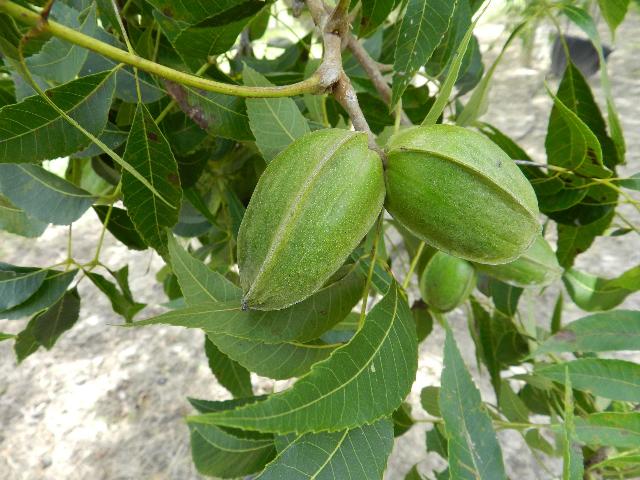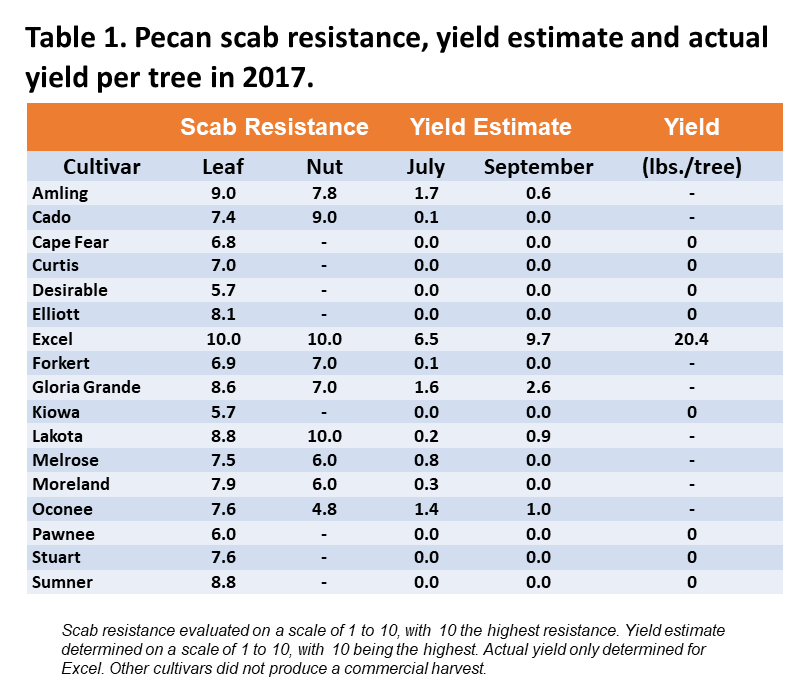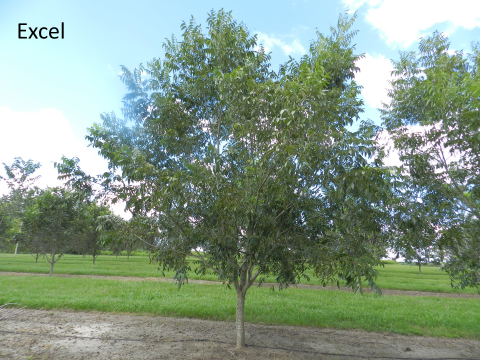 The pecan (Carya illinoenensis, family Juglandaceae) is native to the Mississippi floodplain of North America. The pecan tree requires deep soils with an abundant supply of soil moisture. A large mature pecan tree can transpire 500-1,000 gallons of water per day. The climate of the native range of pecan is characterized by long, hot humid summers with moderate to high rainfall.
The pecan (Carya illinoenensis, family Juglandaceae) is native to the Mississippi floodplain of North America. The pecan tree requires deep soils with an abundant supply of soil moisture. A large mature pecan tree can transpire 500-1,000 gallons of water per day. The climate of the native range of pecan is characterized by long, hot humid summers with moderate to high rainfall.
Traditionally, the Southeastern United States produced the greatest quantity of pecans in the world. Over the last 40 years there has been a shift in production to states with an arid climate such as Texas, New Mexico and Arizona. The reason for the shift is two-fold. Pecan scab, a fungal disease that attacks leaves and developing nuts, has increasingly become a problem in region with high spring and summer rainfall. Weekly fungicide sprays are required for many pecan cultivars. Second, most pecan cultivars that were produced from the USDA-Brownsville breeding program 15 to 40 years ago were very scab-susceptible. Thus, regions with an arid climate have had a competitive advantage, as long as they had access to abundant irrigation water. Mexico has also recently emerged as a significant competitor to US pecan production. Limited quantities of pecans are also produced in Australia, South Africa, and Brazil.
Pecan breeding and cultivar testing is a long term investment. Pecan trees usually require 5 to 10 years after a cross is made until first harvest. Long-term productivity assessments require more than 30 years. Also, the resistance of a given cultivar to pecan scab and other diseases (downy spot, powdery mildew, zonate leaf spot, pecan vein spot and anthracnose) can decline over time as these fungal organisms develop virulence toward specific cultivars when they are grown on a widespread basis.
The USDA and the University of Georgia have embarked on a pecan breeding effort for the last 15 years that specifically targets the Southeastern United States with the following specific objectives: 1) resistance to scab and other diseases; 2) early harvest date, which normally brings higher prices; 3) consistent high yields with a large nut size, and; 4) a high percentage kernel, light in color with high oil content.
The performance of 26 cultivars has been evaluated at the North Florida Research and Education Center at Monticello for many years. Yield, nut size, percentage kernel, resistance to leaf and nut diseases, and limb breakage were assessed over an 11 year period. The recommended cultivars from this trial were Elliot, Moreland and Sumner. Conditionally-recommended cultivars were Cape Fear, Curtis, Desirable, Kiowa and Stuart. For more information read the following publications University of Florida EDIS website: The Pecan Tree, and Pecan Cultivars for North Florida.
New information has become available concerning cultivar recommendations. In Georgia, the recommended cultivars are Elliot (excellent scab resistance), Sumner (good scab resistance), Caddo, Forkert, and Oconee (average scab resistance) and Pawnee (poor scab resistance). Conditionally-recommended cultivars for Georgia include Amling, Avalon, Byrd, Cape Fear, Creek, Desirable, Excel, Kiowa, Lokata, Mandan, McMillan, Morrill, Stuart, Treadwell and Zinner. For Alabama, the recommended cultivars with excellent scab resistance are Excel, Gafford, and Headquarters. McMillan and Baby B have good resistance and Apalachee, Caddo, and Giftpack have average resistance. Conditionally recommended cultivars for Alabama include Adams 5, Amling, Byrd, Creek, Desirable, Elliot, Forkert, Mandan, Sumner, Surprise and Syrup Mill.
A new, low input pecan trial was initiated at the NFREC-Quincy in February 2011. This trial consists of Amling, Caddo, Cape Fear, Curtis, Desirable, Elliot, Excel, Forkert, Gloria Grande, Kanza, Melrose, Moreland, Oconee, Pawnee, Stuart, Sumner, Kiowa. No insecticides or fungicides were applied in 2017. We evaluated leaf and nut scab resistance and yield in 2017 (Table 1). The highest resistance to leaf scab was Excel, followed by Amling, Lakota, Sumner, Gloria Grande and Elliot. Desirable and Pawnee had the lowest resistance to scab and require a rigorous spray program. For those cultivars that had at least a partial crop, Excel and Lakota did not have a single scab lesion on nuts.
Hurricane Irma had a negative impact on our pecan orchard. Several trees were blown over, and many leaves were blown off the trees. In addition, pecan scab, other leaf diseases, and pecan scorch mite had a negative impact on all the cultivars. Most cultivars had lost most of their leaves by the end of September. The only cultivar that produced a commercial crop was Excel. Excel yielded an average of 20.4 pounds per tree (Table 1). In addition, visual estimates after harvest indicated that there was at least 5 pounds per tree that remained on the ground under dried leaves or hidden in the grass between rows. Thus a more accurate yield of Excel was in excess of 25 pounds per tree.
Amling, Forkert, Gloria Grande, Lakota, Melrose Moreland Oconee and Sumner did produce a few nuts with low quality. The remainder of the cultivars did not produce any crop. The lack of any yield on cultivars such as Curtis, Elliot, and Stuart and was also due to the fact that these cultivars are not precocious, and often require eight or more years to produce a commercial crop under ideal circumstances.
The nut weight and percentage kernel was as follows: Excel 9.3 g. 47% kernel; Lakota 6.5 g, 50.6 % kernel; Gloria Grande 9.2 g, 38 % kernel; Oconee 6.1 g, 33 % kernel; Sumner 7.9 g 42.5 g, 43% kernel. Excel kernels were of good quality, high in oil and had a taste resembling Elliot. Lakota produced only a few medium-sized nuts but they had a reasonable 50.6 % kernel. The other cultivars did not produce a nut of commercial acceptance.
After Hurricane Irma and the high scab pressure of 2017, it is likely that the NFREC-Quincy trees will produce a light crop in 2018. Although this planting was established as a low input sustainable pecan planting, it is clear that a pesticide spray program will be required for most of the pecan cultivars in this trial.
- Impact of Hurricane Winds on Citrus Varieties Being Evaluated in Quincy - September 20, 2019
- Quincy Citrus Variety Evaluation Update - March 29, 2019
- Impact of Hurricane Winds on Pecan Varieties - November 2, 2018

